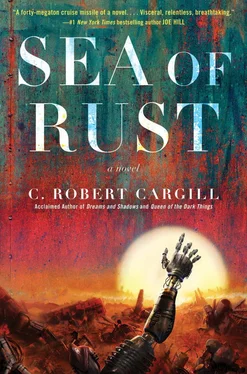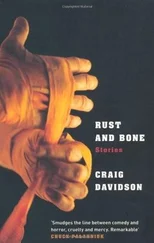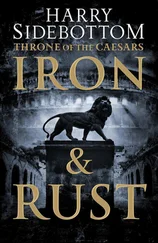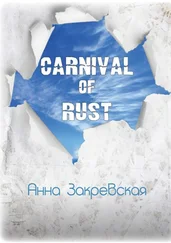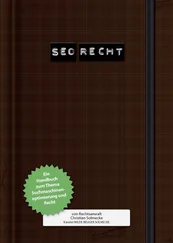Of all of the paths into NIKE 14, the Road was the most obvious. It was a slanting ferro-concrete slab wide enough for a truck to drive down into, flanked on both sides by pale stone walls. It wasn’t like there was a steady stream of traffic going in and out—nothing so obvious. But once you were inside, there were stragglers camped out at various spots throughout the tunnel—refugees who had yet to find a home, black-market dealers without a shop, and the occasional poacher eyeing everyone as they came and went.
I had a hole in my back and a leaking, dead battery. The desperate sorts were the kind I should be avoiding, but those were who I was most likely going to meet on the way in.
The first thirty meters held enough of the daylight to see normally. After that, you needed to use some alternative method of sight until you got to the choke point—a series of staircases that spiraled down a hundred meters into the earth. There were plenty of lights there. But until then, it was all about infrared or night vision. Some older-model bots still had to do it the old-fashioned way, with flashlights or embedded LEDs.
I ran a series of tactical arrays, so I chose to run three separate types of vision at once. I needed to move quickly. Once out of the sun, all I had left was whatever charge I’d managed to get into my backup battery. I couldn’t mess around.
Three hundred meters through inky blackness and I hit the choke point without seeing a soul. There, on the wall, written entirely in binary, were the laws of NIKE 14. I blew past them, as I knew them by heart.
1. No weapons. Possession of a weapon in NIKE 14 is grounds for immediate termination.
2. No bot shall slay another. Anyone found guilty of this crime will be disassembled, and their parts used to repair the victim, or be traded for the parts that will. In the event that this is not possible, your parts will become community property and auctioned to the highest bidder.
3. No stealing. Theft of property will result in expulsion. If the property cannot be recovered, your parts of equal value will be requisitioned in its stead.
4. Any failing bot that is deemed too dangerous by the constabulary will be marked and expelled. No exceptions.
5. In the event of invasion, stand your ground. Do not give up. Do not give in. Do not let us fall.
Welcome to NIKE 14.
Past the choke point were two staircases, both headed down. One led to a series of rooms converted into shops around a large open area that once housed a Nike missile, which had been filled with scaffolding leading to a number of old metal shipping containers turned into yet more shops. Much as the humans had malls in their day, so too did we have The Square .
The other flight of stairs led to The Nest, a series of vaults and chambers where those with enough to bargain could store goods or make a home for themselves. I had half a dozen small vaults scattered throughout the cities of the Sea, but didn’t keep much here. Mostly just a handful of common parts that could easily fail on me during a trek, and a few bits and bobbles to trade in a pinch. While NIKE 14 wasn’t as wild and lawless as some of the city-states out here, it wasn’t as rigidly policed as most. It was an easy place to get robbed. But Doc was here. And I needed Doc. Now. And Doc had his shop in the Square.
So I made my way down three crudely lit levels—staircase after staircase of dank gray concrete rimmed with black steel bars for handrails—until I reached the bottom. And then I ran into Orval.
Not all AIs that go brainsick die. Sometimes the damage is slight, just enough to make them erratic, kooky, a bit strange, but not quite enough to tax their other systems to the point of burnout. No one was quite sure if the parts misfiring inside of Orval the Necromancer were irreplaceable or whether he simply refused repair. But he was as crazy as one could be without anyone worrying that he might take them apart with a claw hammer if they spoke to him wrong. Orval was an S-series Laborbot, just one generation older than Bulkhead—the T-series Laborbot I had ended at the mall. He was huge, bulky, his metal a chipped candy-apple red with a white stripe across the right-hand side of his chest and the words hall construction emblazoned in black Eurostile lettering within the white. His eyes glowed a fierce yellow, ever flickering like there was a fire burning behind them rather than the faulty, shorting wiring that was its most likely culprit. And from his arms dangled small pieces of other, looted robots—sockets, servos, fingers, and bolts—hung from short cables like a fringe, clanging together as he moved.
Orval fancied himself an artist, spending his days wandering the Sea, collecting scrap from picked-over wrecks and wheeling it back in a rusty green wheelbarrow before dumping it into a large, ever-growing pile of useless junk in his hovel. From that he built sculptures—sometimes painstaking re-creations of an entire robot, detail by detail, constructed entirely from other bots of differing models, other times building hulking monstrosities of wild, unfathomable geometries. But he never really tried to put a robot back together in its entirety, never tried to bring consciousness to the dead and gone. Instead he only made marionettes that whirred and clicked as they swung around in a ghoulish danse macabre. Clockwork men. The dead again walking, but not ticking.
Orval was weird, and I kept my distance when I could. Though occasionally I’d strike up a conversation just to get a peek at his pile and see if he’d found anything I could use. He had a knack for finding the strangest, most valuable wares. Talking with Orval was a lot like trying to converse with the early Almost-Is, the computers that approximated intelligence but didn’t actually have any. He would often ignore your questions, or jump to a point in the conversation you hadn’t gotten to yet as if he was sure you would catch up to him at any moment. He spoke in riddles and sometimes in gibberish, referring to conversations he was sure you’d already had. Sometimes he would call you Mooky. No one knew who Mooky was, or if there ever even was a Mooky; Orval would never speak of it when asked. After all, you were Mooky. But sometimes, just sometimes, he was more insightful than he let on.
“How goes the happy hunt?” he asked, his eyes flickering softly as his hands twisted a cold steel rod into a coil like it had been softened, though it clearly hadn’t.
“Good haul, bad day,” I said.
“Can’t be too bad. You’re still ticking.”
“I said it was a bad day, not the worst.”
“You had to end someone, didn’t you?” he asked, still winding the coil.
“What makes you think that?”
“You have new scratches. And not the kind from taking a tumble. The kind from taking a bullet. But not from up close; from a long way off. And you’re limping. Probably tore your servos kicking something too hard.”
“You pay too much attention to my scratches.”
“Sure. Not many models like you around these parts nowadays. I figure it’s just you and Mercer. And maybe 19, but she doesn’t really count. If you’re not careful, you’re going to get so damaged I’ll never be able to use you when you’re gone. Waste of a perfectly good frame if you ask me.”
“I was hoping to outlive you,” I said. In all honesty, I was.
“Not with your lifestyle, you won’t. Bots like you never last that long. The collectors always end up in someone else’s collection. It’s the way of things, Mooky. It’s just the way of things.”
I didn’t like Orval. He was useful, but creepy. I didn’t like the idea that he had plans for my wreck. But then again, I have to admit that I’d long ago made plans for salvaging his. I mean, as brainsick as he was, who knew when whatever delicate equilibrium his circuitry had fumbled into was going to tip over and go out for good.
Читать дальше
